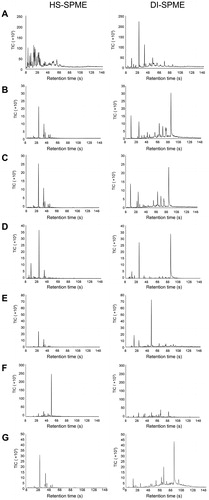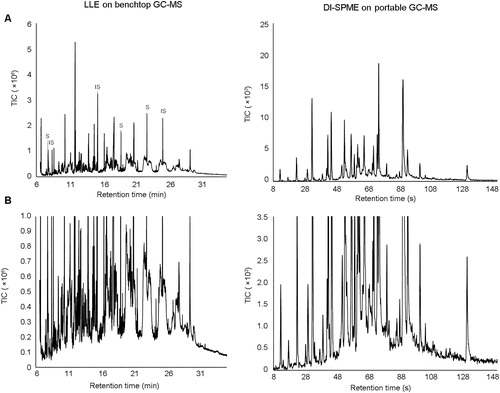Figures & data
Table 1. Run-off water samples collected from controlled fires. Ten mL of run-off water was placed into each vial. Each set of four vials was collected for each controlled fire, including for the fires containing only paper and cardboard.
Figure 1. Representative portable gas chromatography-mass spectrometry (GC-MS) chromatograms of water run-off samples collected after extinguishment of fires consisting of (A) background paper and cardboard (max temp. ∼600 °C), (B) particle board (max temp. ∼500 °C), (C) melamine coated particle board (max temp. ∼500 °C), (D) laminated wood (max temp. ∼600 °C), (E) carpet (max temp. ∼300 °C), (F) rubber (max temp. ∼550 °C) and (G) underlay (max temp. ∼650 °C). Samples were extracted using both headspace sampling-solid phase microextraction sampling (HS-SPME) and direct immersion sampling-solid phase microextraction sampling (DI-SPME). Chromatograms have been adjusted to the same scale for direct comparison between the two extraction methods.

Table 2. Target compound list for in-field fire run-off water sampling and analysis.
Figure 2. Representative benchtop gas chromatography-mass spectrometry (GC-MS) chromatogram compared to a portable GC-MS chromatogram of water run-off from a controlled burn of rubber after extraction using direct immersion sampling-solid phase microextraction sampling (DI-SPME), where (A) is a complete overview of the chromatogram and (B) is an expanded section of the baseline of the same result. The major peaks (1–7) present within the benchtop GC-MS results were also detected and identified on the portable GC-MS (see also ); 1) Unknown 11, 2) naphthalene, 3) benzothaizole, 4) dihydrotrimethylquinoline, 5) bis(dimethylethyl)phenol, 6) (methylthio)-benzothiazole, 7) bis(methylene)-benzenamine.

Figure 3. Representative benchtop gas chromatography-mass spectrometry (GC-MS) chromatogram of run-off water from a controlled burn of rubber after liquid-liquid extraction (LLE) compared to a portable GC-MS chromatogram of water run-off from a controlled burn of rubber after extraction using direct immersion sampling-solid phase microextraction sampling (DI-SPME), where (A) is a complete overview of the chromatogram and (B) is an expanded section of the same result. Surrogate compounds and internal standards in the extracted sample are denoted with “S” and “IS”, respectively.

Table 3. Compounds detected and identified using conventional laboratory-based sampling and analysis of fire water run-off.
